北师大版(2019)必修 第三册Unit 8 Green living Lesson 1 Roots and Shoots公开课课件(共59张PPT)
文档属性
| 名称 | 北师大版(2019)必修 第三册Unit 8 Green living Lesson 1 Roots and Shoots公开课课件(共59张PPT) |  | |
| 格式 | pptx | ||
| 文件大小 | 953.8KB | ||
| 资源类型 | 教案 | ||
| 版本资源 | 北师大版(2019) | ||
| 科目 | 英语 | ||
| 更新时间 | 2023-03-07 21:27:08 | ||
图片预览

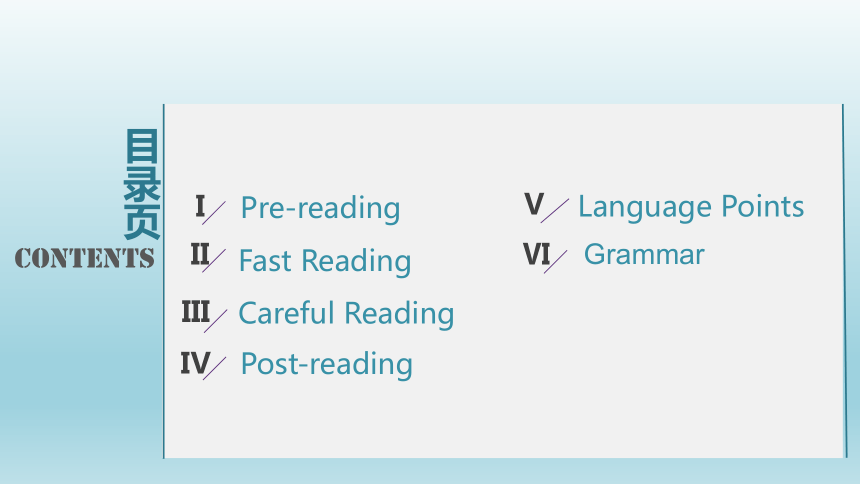

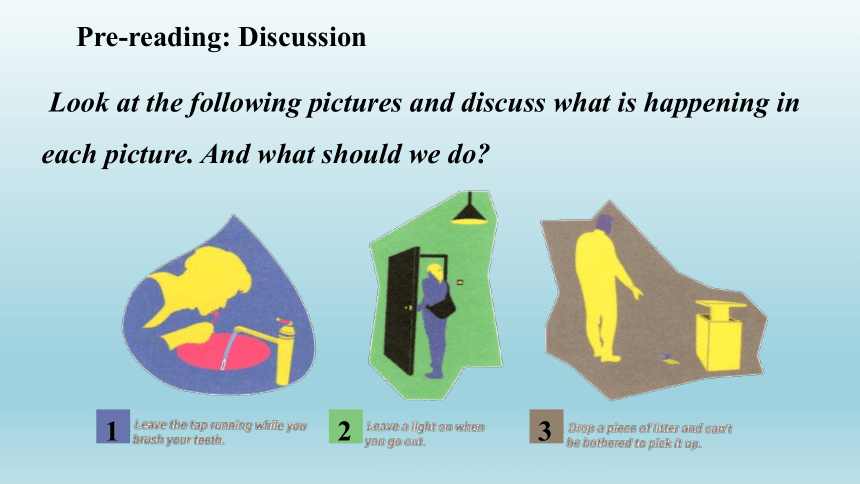
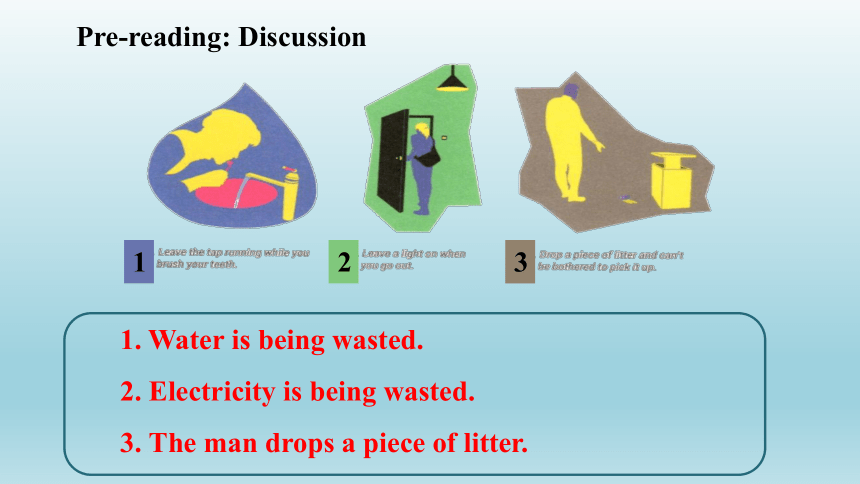

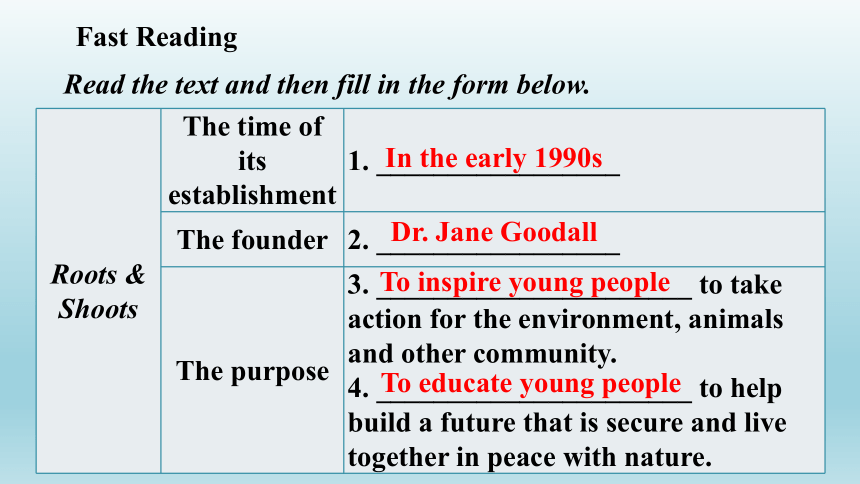
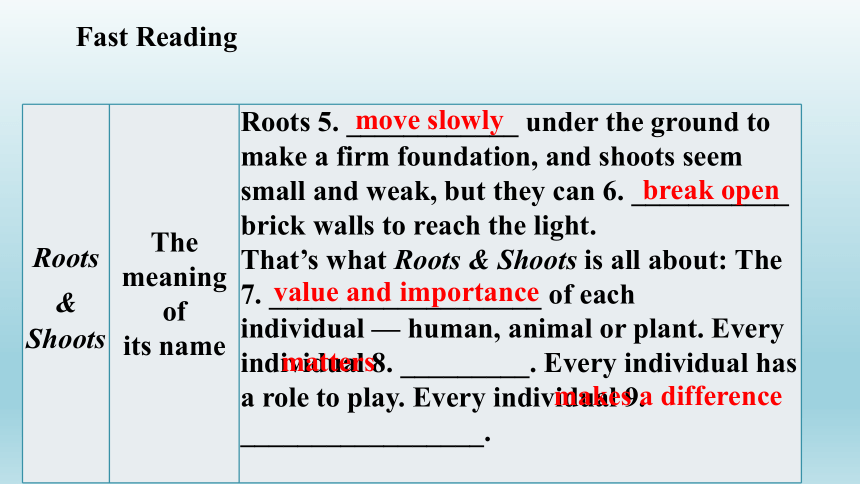

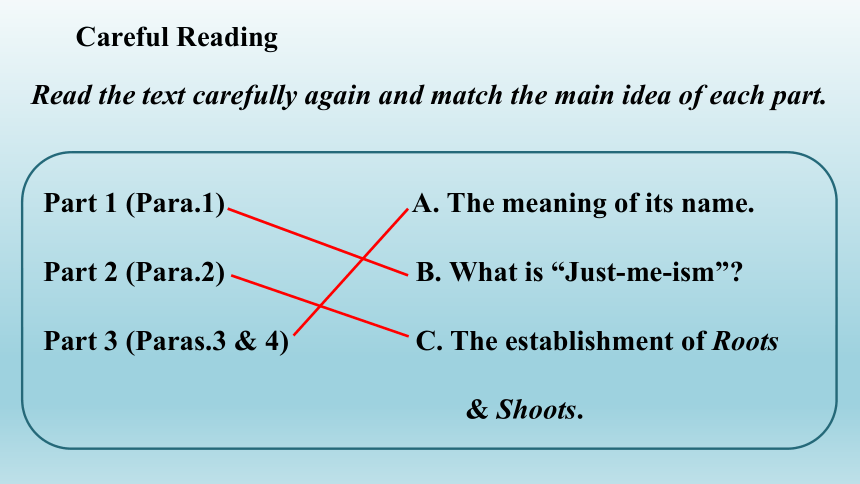
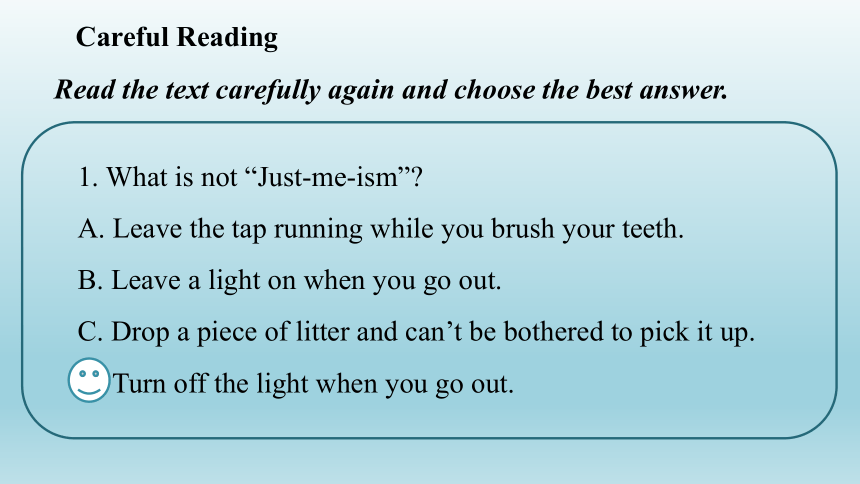

文档简介
(共59张PPT)
Unit 8 GREEN LIVING
Lesson 1 Roots and Shoots
目录页
contents
Pre-reading
I
Post-reading
IV
Fast Reading
II
Grammar
V
III
Careful Reading
Ⅵ
Language Points
Ⅰ
Pre-reading
Look at the following pictures and discuss what is happening in each picture. And what should we do
Pre-reading: Discussion
1
2
3
1. Water is being wasted.
2. Electricity is being wasted.
3. The man drops a piece of litter.
1
2
3
Pre-reading: Discussion
Ⅱ
Fast Reading
Read the text and then fill in the form below.
Roots & Shoots The time of its establishment 1. _________________
The founder 2. _________________
The purpose 3. ______________________ to take action for the environment, animals and other community.
4. ______________________ to help build a future that is secure and live together in peace with nature.
In the early 1990s
To educate young people
Fast Reading
Dr. Jane Goodall
To inspire young people
Roots & Shoots The meaning of its name Roots 5. ____________ under the ground to make a firm foundation, and shoots seem small and weak, but they can 6. ___________ brick walls to reach the light.
That’s what Roots & Shoots is all about: The 7. ___________________ of each individual — human, animal or plant. Every individual 8. _________. Every individual has a role to play. Every individual 9. _________________.
move slowly
break open
value and importance
matters
makes a difference
Fast Reading
Careful Reading
Ⅲ
Read the text carefully again and match the main idea of each part.
Part 1 (Para.1) A. The meaning of its name.
Part 2 (Para.2) B. What is “Just-me-ism”
Part 3 (Paras.3 & 4) C. The establishment of Roots
& Shoots.
Careful Reading
Read the text carefully again and choose the best answer.
1. What is not “Just-me-ism”
A. Leave the tap running while you brush your teeth.
B. Leave a light on when you go out.
C. Drop a piece of litter and can’t be bothered to pick it up.
D. Turn off the light when you go out.
Careful Reading
2. Who is Jane Goodall
A. A scientist who’s the world’s best-known expert on wild chimpanzees.
B. A scientist who’s the world’s best-known expert on wild monkeys.
C. A scientist who’s the world’s best-known expert on wild tigers.
D. A scientist who’s the world’s best-known expert on wild wolves.
Careful Reading
3. What can we learn from the text
A. Every individual doesn’t matter.
B. Every individual can make a difference to the world.
C. Only a few people suffer from “Just-me-ism”.
D. People can’t live together in peace with nature.
Careful Reading
Post-reading
Ⅳ
What techniques does the writer use to make her view logical and convincing
Post-reasding: Pair work
Share your idea with the classmates.
The writer uses the parallel structures that help us understand the writer’s point.
when and where it was established
the meaning of its name
the contribution it makes to society
Post-reasding: Group work
Prepare a presentation to introduce Roots & Shoots with the following tips. Then give your presentation.
Language Points
Ⅴ
体会句中红粗单词的词性和含义
1. The whole purpose of Roots & Shoots is to educate young people, from pre-schoolers to university students, so they can help to build a future that is secure and live together in peace with nature.
____________________
2. The organization is called Roots & Shoots because roots move slowly under the ground to make a firm foundation, and shoots seem small and weak, but they can break open brick walls to reach the light. _____________ _____________
adj 安全的
n 基础;地基
n 芽;苗
Focus on Language: Difficult Words
3. One cheered-up person, one happy dog, one flowering plant, and you. ____________
adj 开花的
Focus on Language: Difficult Words
1. leave the tap running _______________________
2. drop a piece of litter _______________________
3. so what _______________________
4. say to oneself _______________________
5. in the early 1990s _______________________
6. live together in peace with nature _______________________
7. make a firm foundation _______________________
8. make it a better place to live in _______________________
让水龙头开着流水
掉一片 / 块垃圾
那又怎样
心中暗想;对自己说
在20世纪90年代初
与自然和平相处 / 共处
形成坚实的基础
使其更加宜居
Focus on Language: Difficult Phrases
1. shoot n 芽;苗;嫩枝;射击
v 射击;射中;拍摄;飞驰
写出下列句中shoot的含义
① He shot the arrow from the bow (弓). ____________
② The movie was shot in black and white. ____________
③ The boy shot past me on his bike. ____________
射(箭)
拍摄
飞驰
Focus on Language: Important Words
翻译:
① 我们撒下种子两周后,绿色的小苗开始冒出来。
_________________________________________________
_________________________________________________
② 猎手向远处的那头鹿开了枪。
_________________________________________________
③ 那位篮球运动员投进了一球。
_________________________________________________
Two weeks after we’d planted the seeds, little green shoots started to appear.
The hunter shot at the deer in the distance.
The basketball player shot the ball into the net.
Focus on Language: Exercise
Don’t involve me in your quarrel! ________
He was involved in reading the novel all morning. _________
2. involve vt 参与;包含 involved adj 有关的;卷入的
牵扯进
专心地
① involve sb ____________ (doing) sth
(邀请 / 允许)某人参与(做)某事;把某人牵涉 / 牵扯到某事里
② be involved ____________ doing sth 参与做某事
in
in
Focus on Language: Important Words
1. not be bothered to do sth 懒得做某事
Drop a piece of litter and can’t be bothered to pick it up. (教材P30)
掉了一块垃圾却懒得捡起来。
花时间 / 精力做某事
bother to do sth
bother doing sth
bother with / about sth
Focus on Language: Important Phrases
2. take action 采取行动
To inspire young people to take action for the environment, animals and their community, Roots & Shoots was established. (教材P31)
为了激励年轻人行动起来保护环境、动物和社区,“根与芽”诞生了。
take steps / measures 采取措施 take a risk 冒(风)险
take a chance 冒险 take your chance 碰运气 take effect 生效;起作用 take advantage of 利用……
Focus on Language: Important Phrases
The organization is called Roots & Shoots because roots move slowly under the ground to make a firm foundation, and shoots seem small and weak, but they can break open brick walls to reach the light.
because引导原因状语从句;and, but引导并列句
Dr. Jane Goodall believes that the most important thing is that: “Every individual matters. Every individual has a role to play. Every individual makes a difference.”
第一个that 引导宾语从句;第二个that 引导表语从句
Focus on Language: Difficult Sentences
1
Most people suffer from what is known as “Just-me-ism”.
__________________________________________________________________
很多人都有所谓的“就我一个人”的问题。
句中what is known as “ Just-me-ism”为what引导的宾语从句。
Focus on Language: Difficult Sentences
... say you leave the tap running while you brush your teeth...
例如,你刷牙的时候让水哗哗地流……
[句式解读] 句中while引导时间状语从句,意为“当……的时候”。
1) “当……的时候”,表示时间,引导时间状语从句,从句谓语用延续性动词。
She was cooking while she was keeping an eye on her baby sleeping in the cradle.
她一边做饭,一边照看睡在摇篮里的婴儿。
Focus on Language: Difficult Sentences
2
2) “只要”,表示条件,引导条件状语从句。
While there is a will, there is a way. 有志者事竟成。
3) “但是;可是”,表示对比,连接两个并列句。
The boy is good at maths while his sister is good at Chinese.
那个男孩擅长数学而他妹妹擅长语文。
4) “虽然;尽管”,表示转折,引导让步状语从句。
While he loves his students, he is very strict with them.
虽然他爱他的学生,可是他对他们很严格。
Focus on Language: Difficult Sentences
Hundreds and thousands of roots and shoots can solve the problems, change the world and make it a better place to live in. _______________________________________________________
It is by acting together, in this exciting way, that we can involve thousands — millions — of people, and this is what is going to change the world. _______________________________________________________
_______________________________________________________
成千上万的根与芽能够解决问题、改变世界、使其更加宜居。
正是通过这种令人激动的方式共同行动起来,我们可以让成百上千、甚至千百万人参与其中,这将改变世界。
Focus on Language: Difficult Sentences
3
4
Grammar
VI
Focus on Grammar: 动词-ing和-ed形式
eg: A young man writing novels came to speak to us yesterday. 定语
① The experiment was an amazing success.
② Li Ming’s hobby is collecting stamps.
③ When I walked into the office, I saw a girl using my computer.
④ He comes home late every evening, making his wife very angry.
定语
表语
宾补
状语
画出下列句子中的 “动词-ing形式和动词-ed形式” 结构,并指出其所作的句子成分。
_______
________
____
______
Focus on Grammar: 动词-ing和-ed形式
⑤ What’s the language spoken in that area
⑥ We were surprised at what he said at the meeting.
⑦ She found her necklace gone on her way home.
总结:
动词-ing形式可以在句中作 _____________________________。
动词-ed形式可以在句中作 _____________________________。
定语
表语
宾补
定语、状语、表语和宾语补足语
定语、状语、表语和宾语补足语
______
_______
____
Focus on Grammar: 动词-ing和-ed形式
一、动词-ing形式
1.作定语
No one is allowed to speak aloud in the reading room.
阅览室里不准大声说话。
A little child learning (= who is learning) to walk often falls.
学走路的小孩常常跌跤。
There are many students waiting (= who are waiting) to get examined.
有许多学生在等待检查。
Focus on Grammar: 动词-ing形式
2.作状语
Hearing the noise, I turned around.
=When I heard the noise, I turned around.
听到响声我转过身去。
Being poor, he couldn’t afford a TV set.
=Because he was poor, he couldn’t afford a TV set.
由于贫穷,他买不起电视机。
一、动词-ing形式
Focus on Grammar: 动词-ing形式
Working hard, you’ll certainly succeed.
=If you work hard, you’ll certainly succeed.
只要努力学习,你肯定会成功的。
The fire lasted a whole night, causing great damage.
大火持续了一整夜,造成了巨大损失。
Mary sat by the window of the classroom, reading a book.
=Mary sat by the window of the classroom and was reading a book.
玛丽坐在教室的窗边读书。
Focus on Grammar: 动词-ing形式
现在分词作状语时可以表示时间、原因、条件、结果、让步、方式和伴随状况;作方式状语和伴随状语时,可以变为并列分句;作其他状语时,可以变为相应的 _______ 从句。
状语
Focus on Grammar: 动词-ing形式
3.作宾语补足语
I saw a small girl standing in front of a fishbowl.
我看到一个小女孩站在鱼缸前。
I saw that thief getting on the train.
我看见那个贼正在上火车。
I saw the thief get on the train and disappear.
我看见那个贼上了火车,消失不见了。
I couldn’t do my homework with the noise going on.
在持续的噪音下我无法完成作业。
一、动词-ing形式
Focus on Grammar: 动词-ing形式
现在分词在句子中可用作宾语补足语,句子中的宾语和宾语补足语在逻辑上是 _______ 关系。
feel, find, hear, notice, observe, see, watch等感官动词,既可以跟现在分词也可以跟不带to的不定式作宾语补足语。现在分词作句子中的宾语补足语,表示动作 ________ 进行;不带to的不定式作句子中的宾语补足语,表示动作的完成。
主动
正在
Focus on Grammar: 动词-ing形式
4.作表语
The result of the game was disappointing.
比赛结果令人失望。
His life story sounds very moving.
他的人生故事听起来很感人。
What I am tired of is waiting here alone.
我厌烦独自在这里等。
My hobby is collecting stamps.
我的爱好就是集邮。
一、动词-ing形式
Focus on Grammar: 动词-ing形式
作表语的动词-ing形式包括现在分词和动名词。现在分词作表语,往往具有 _______ 的性质,说明主语的性质、特征等;动名词作表语多表示抽象性的或 ______ 的动作,一般说明主语的内容。
形容词
习惯性
Focus on Grammar: 动词-ing形式
1. China is a ____________ (develop) country ____________ (belong) to the third world.
2. Ladies and gentlemen, please go and wait in the _________ (meet) room.
3. That must have been a ____________ (terrify) experience.
4. The girl who was sitting next to me was my cousin.
→ The girl ________________ was my cousin.
developing
belonging
meeting
terrifying
sitting next to me
单句语法填空 / 同义句转换
Focus on Grammar: Exercise
5. ____________, the boy couldn’t focus on his study.
因为很困,这个男孩不能把注意力集中在学习上。
6. ___________________________, you will master this language step by step.
每天都用英语说话,你会一步一步掌握这门语言。
7. I stared at the dark sky _______________ where I would belong.
凝望着漆黑的夜空,我心里思索着路在何方。
8. He arrives at school very late every day, _____________________
________.
他每天都很晚到达学校,这让他的老师很生气。
Being sleepy
Speaking in English every day
thinking about
making his teacher very
angry
Focus on Grammar: Exercise
9. ___________________, I saw him.
当我在街上走时,我看到他了。
10. He saw her ____________________.
他看见她正在花园里干活。
11. I could feel the wind ________ on my face.
我能感觉到风吹着我的脸。
12. He saw her ______________.
他看见她走进屋子。
13. With so many people __________ her, she felt nervous.
这么多人看着她,她感到紧张。
working in the garden
blowing
enter the room
looking at
Walking in the street
Focus on Grammar: Exercise
14. What he said was _____________.
他说的话鼓舞人心。
15. Her letter was __________.
她的信很感人。
16. The news was ________.
这消息令人兴奋。
17. My job is _________.
我的工作是教书。
encouraging
touching
exciting
teaching
Focus on Grammar: Exercise
1.作定语
The broken vase has been thrown outside.
那个碎了的花瓶已被扔到外面去了。
I borrowed a book written (= that / which was written) by Mark Twain from the library.
我从图书馆里借了一本马克·吐温写的书。
二、动词-ed形式
Focus on Grammar: 动词-ed形式
单个的过去分词作定语一般放在被修饰的名词之 _____;过去分词短语作定语要放在被修饰的名词后面作 _______ 定语,其作用相当于一个定语从句。
前
后置
Focus on Grammar: 动词-ed形式
2.作宾语补足语
When I came in, I found a strange girl seated in the corner.
我进来时,发现一个陌生的女孩坐在角落里。
I want the letter posted.
我想把这封信寄出去。
She found her necklace gone on her way home.
在回家的路上,她发现项链不见了。
二、动词-ed形式
Focus on Grammar: 动词-ed形式
及物动词(短语)的过去分词用作宾语补足语时,宾语即是过去分词的逻辑宾语,宾语和过去分词之间存在逻辑上的 ______ 关系。少数不及物动词如 go, change, fall 等的过去分词作宾语补足语时,仅表示 ____________。
被动
动作完成
Focus on Grammar: 动词-ed形式
3.作表语
The door remained locked.
门仍然锁着。
Later they found that they were lost.
后来他们发现他们迷路了。
We were amazed at the beauty of the lake.
这个湖泊的美使我们大为惊奇。
二、动词-ed形式
Focus on Grammar: 动词-ed形式
过去分词作表语,多表示主语所处的状态或所具备的特征,多位于 __________ 之后,这些系动词有be, remain, feel, seem, look, become等。有些过去分词作表语时,已经具备了 ______ 的性质。
系动词
形容词
Focus on Grammar: 动词-ed形式
4.作状语
Caught in a heavy rain,he was all wet.
因为淋了一场大雨,所以他全身湿透了。
Grown in rich soil,these seeds can grow fast.
如果种在肥沃的土壤里,这些种子能长得很快。
Asked about the matter, she kept silent.
当被问及那个问题时,她默不作声。
二、动词-ed形式
Focus on Grammar: 动词-ed形式
过去分词作状语时,过去分词所表示的动作与句子的主语之间是逻辑上的 ______ 关系,即表被动。
过去分词作条件、原因及时间状语时,通常放在句首;作伴随状语时通常放在 _____;作方式状语时,一般放在句末,有时也放在句首。
动宾
句末
The old man walked into the room, supported by his son.
这位老人在儿子的搀扶下走进了房间。
He walked slowly in the forest, followed by a dog.
他在森林里慢慢地走着,后面跟着一条狗。
Focus on Grammar: 动词-ed形式
1. Did you accept the invitation ____________ (give) by the tour guide
2. Most of the artists ____________ (invite) to the party were from South Africa.
3. The speaker answered all the questions ____________ (raise) by the audience.
4. You should improve your ____________ (speak) English.
given
invited
raised
spoken
单句语法填空
Focus on Grammar: Exercise
5. She was ____________ (surprise) to find the fridge empty.
6. She looked ____________ (tire) with cooking.
7. They were ____________ (delight) to hear the delighting news.
8. The bookstore is now ____________(close).
surprised
tired
delighted
closed
Focus on Grammar: Exercise
9. I saw an old man ________________ by a car just now.
刚才我看到一位老人被车撞倒了。
10. I’ll ____________________ tomorrow.
明天我要理发。
11. I heard the song ___________________.
我听到有人用英语唱过这首歌。
12. Don’t ___________________________.
要把那些事情做完。
knocked down
have my hair cut
sung in English
leave those things undone
Focus on Grammar: Exercise
13. _________________________ he has made, he works harder.
由于受到所取得的进步的鼓舞,他更努力工作了。
14. _________________________, the city looks more beautiful.
从山顶看城市,城市显得更漂亮。
15. __________________, I can also work out this problem.
再给我一个小时,我也能解这道题。
16. _________________, this article was not so good!
因为写得匆忙,这篇文章不是很好。
17. He stood there silently, ______________.
他静静地站在那里,被感动得热泪盈眶。
Encouraged by the progress
Seen from the top of the hill
Given another hour
Written in a hurry
moved to tears
Focus on Grammar: Exercise
总结:
动词-ing形式是非谓语动词的一种形式,包括现在分词和动名词两种。动名词在句中作主语、宾语、表语和定语;现在分词在句中作状语、宾语补足语、表语和定语。
动词-ed形式是非谓语动词的一种形式,表示被动和完成,在句中作定语、表语、宾语补足语和状语。
Focus on Grammar: 动词-ing和-ed形式
Unit 8 GREEN LIVING
Lesson 1 Roots and Shoots
目录页
contents
Pre-reading
I
Post-reading
IV
Fast Reading
II
Grammar
V
III
Careful Reading
Ⅵ
Language Points
Ⅰ
Pre-reading
Look at the following pictures and discuss what is happening in each picture. And what should we do
Pre-reading: Discussion
1
2
3
1. Water is being wasted.
2. Electricity is being wasted.
3. The man drops a piece of litter.
1
2
3
Pre-reading: Discussion
Ⅱ
Fast Reading
Read the text and then fill in the form below.
Roots & Shoots The time of its establishment 1. _________________
The founder 2. _________________
The purpose 3. ______________________ to take action for the environment, animals and other community.
4. ______________________ to help build a future that is secure and live together in peace with nature.
In the early 1990s
To educate young people
Fast Reading
Dr. Jane Goodall
To inspire young people
Roots & Shoots The meaning of its name Roots 5. ____________ under the ground to make a firm foundation, and shoots seem small and weak, but they can 6. ___________ brick walls to reach the light.
That’s what Roots & Shoots is all about: The 7. ___________________ of each individual — human, animal or plant. Every individual 8. _________. Every individual has a role to play. Every individual 9. _________________.
move slowly
break open
value and importance
matters
makes a difference
Fast Reading
Careful Reading
Ⅲ
Read the text carefully again and match the main idea of each part.
Part 1 (Para.1) A. The meaning of its name.
Part 2 (Para.2) B. What is “Just-me-ism”
Part 3 (Paras.3 & 4) C. The establishment of Roots
& Shoots.
Careful Reading
Read the text carefully again and choose the best answer.
1. What is not “Just-me-ism”
A. Leave the tap running while you brush your teeth.
B. Leave a light on when you go out.
C. Drop a piece of litter and can’t be bothered to pick it up.
D. Turn off the light when you go out.
Careful Reading
2. Who is Jane Goodall
A. A scientist who’s the world’s best-known expert on wild chimpanzees.
B. A scientist who’s the world’s best-known expert on wild monkeys.
C. A scientist who’s the world’s best-known expert on wild tigers.
D. A scientist who’s the world’s best-known expert on wild wolves.
Careful Reading
3. What can we learn from the text
A. Every individual doesn’t matter.
B. Every individual can make a difference to the world.
C. Only a few people suffer from “Just-me-ism”.
D. People can’t live together in peace with nature.
Careful Reading
Post-reading
Ⅳ
What techniques does the writer use to make her view logical and convincing
Post-reasding: Pair work
Share your idea with the classmates.
The writer uses the parallel structures that help us understand the writer’s point.
when and where it was established
the meaning of its name
the contribution it makes to society
Post-reasding: Group work
Prepare a presentation to introduce Roots & Shoots with the following tips. Then give your presentation.
Language Points
Ⅴ
体会句中红粗单词的词性和含义
1. The whole purpose of Roots & Shoots is to educate young people, from pre-schoolers to university students, so they can help to build a future that is secure and live together in peace with nature.
____________________
2. The organization is called Roots & Shoots because roots move slowly under the ground to make a firm foundation, and shoots seem small and weak, but they can break open brick walls to reach the light. _____________ _____________
adj 安全的
n 基础;地基
n 芽;苗
Focus on Language: Difficult Words
3. One cheered-up person, one happy dog, one flowering plant, and you. ____________
adj 开花的
Focus on Language: Difficult Words
1. leave the tap running _______________________
2. drop a piece of litter _______________________
3. so what _______________________
4. say to oneself _______________________
5. in the early 1990s _______________________
6. live together in peace with nature _______________________
7. make a firm foundation _______________________
8. make it a better place to live in _______________________
让水龙头开着流水
掉一片 / 块垃圾
那又怎样
心中暗想;对自己说
在20世纪90年代初
与自然和平相处 / 共处
形成坚实的基础
使其更加宜居
Focus on Language: Difficult Phrases
1. shoot n 芽;苗;嫩枝;射击
v 射击;射中;拍摄;飞驰
写出下列句中shoot的含义
① He shot the arrow from the bow (弓). ____________
② The movie was shot in black and white. ____________
③ The boy shot past me on his bike. ____________
射(箭)
拍摄
飞驰
Focus on Language: Important Words
翻译:
① 我们撒下种子两周后,绿色的小苗开始冒出来。
_________________________________________________
_________________________________________________
② 猎手向远处的那头鹿开了枪。
_________________________________________________
③ 那位篮球运动员投进了一球。
_________________________________________________
Two weeks after we’d planted the seeds, little green shoots started to appear.
The hunter shot at the deer in the distance.
The basketball player shot the ball into the net.
Focus on Language: Exercise
Don’t involve me in your quarrel! ________
He was involved in reading the novel all morning. _________
2. involve vt 参与;包含 involved adj 有关的;卷入的
牵扯进
专心地
① involve sb ____________ (doing) sth
(邀请 / 允许)某人参与(做)某事;把某人牵涉 / 牵扯到某事里
② be involved ____________ doing sth 参与做某事
in
in
Focus on Language: Important Words
1. not be bothered to do sth 懒得做某事
Drop a piece of litter and can’t be bothered to pick it up. (教材P30)
掉了一块垃圾却懒得捡起来。
花时间 / 精力做某事
bother to do sth
bother doing sth
bother with / about sth
Focus on Language: Important Phrases
2. take action 采取行动
To inspire young people to take action for the environment, animals and their community, Roots & Shoots was established. (教材P31)
为了激励年轻人行动起来保护环境、动物和社区,“根与芽”诞生了。
take steps / measures 采取措施 take a risk 冒(风)险
take a chance 冒险 take your chance 碰运气 take effect 生效;起作用 take advantage of 利用……
Focus on Language: Important Phrases
The organization is called Roots & Shoots because roots move slowly under the ground to make a firm foundation, and shoots seem small and weak, but they can break open brick walls to reach the light.
because引导原因状语从句;and, but引导并列句
Dr. Jane Goodall believes that the most important thing is that: “Every individual matters. Every individual has a role to play. Every individual makes a difference.”
第一个that 引导宾语从句;第二个that 引导表语从句
Focus on Language: Difficult Sentences
1
Most people suffer from what is known as “Just-me-ism”.
__________________________________________________________________
很多人都有所谓的“就我一个人”的问题。
句中what is known as “ Just-me-ism”为what引导的宾语从句。
Focus on Language: Difficult Sentences
... say you leave the tap running while you brush your teeth...
例如,你刷牙的时候让水哗哗地流……
[句式解读] 句中while引导时间状语从句,意为“当……的时候”。
1) “当……的时候”,表示时间,引导时间状语从句,从句谓语用延续性动词。
She was cooking while she was keeping an eye on her baby sleeping in the cradle.
她一边做饭,一边照看睡在摇篮里的婴儿。
Focus on Language: Difficult Sentences
2
2) “只要”,表示条件,引导条件状语从句。
While there is a will, there is a way. 有志者事竟成。
3) “但是;可是”,表示对比,连接两个并列句。
The boy is good at maths while his sister is good at Chinese.
那个男孩擅长数学而他妹妹擅长语文。
4) “虽然;尽管”,表示转折,引导让步状语从句。
While he loves his students, he is very strict with them.
虽然他爱他的学生,可是他对他们很严格。
Focus on Language: Difficult Sentences
Hundreds and thousands of roots and shoots can solve the problems, change the world and make it a better place to live in. _______________________________________________________
It is by acting together, in this exciting way, that we can involve thousands — millions — of people, and this is what is going to change the world. _______________________________________________________
_______________________________________________________
成千上万的根与芽能够解决问题、改变世界、使其更加宜居。
正是通过这种令人激动的方式共同行动起来,我们可以让成百上千、甚至千百万人参与其中,这将改变世界。
Focus on Language: Difficult Sentences
3
4
Grammar
VI
Focus on Grammar: 动词-ing和-ed形式
eg: A young man writing novels came to speak to us yesterday. 定语
① The experiment was an amazing success.
② Li Ming’s hobby is collecting stamps.
③ When I walked into the office, I saw a girl using my computer.
④ He comes home late every evening, making his wife very angry.
定语
表语
宾补
状语
画出下列句子中的 “动词-ing形式和动词-ed形式” 结构,并指出其所作的句子成分。
_______
________
____
______
Focus on Grammar: 动词-ing和-ed形式
⑤ What’s the language spoken in that area
⑥ We were surprised at what he said at the meeting.
⑦ She found her necklace gone on her way home.
总结:
动词-ing形式可以在句中作 _____________________________。
动词-ed形式可以在句中作 _____________________________。
定语
表语
宾补
定语、状语、表语和宾语补足语
定语、状语、表语和宾语补足语
______
_______
____
Focus on Grammar: 动词-ing和-ed形式
一、动词-ing形式
1.作定语
No one is allowed to speak aloud in the reading room.
阅览室里不准大声说话。
A little child learning (= who is learning) to walk often falls.
学走路的小孩常常跌跤。
There are many students waiting (= who are waiting) to get examined.
有许多学生在等待检查。
Focus on Grammar: 动词-ing形式
2.作状语
Hearing the noise, I turned around.
=When I heard the noise, I turned around.
听到响声我转过身去。
Being poor, he couldn’t afford a TV set.
=Because he was poor, he couldn’t afford a TV set.
由于贫穷,他买不起电视机。
一、动词-ing形式
Focus on Grammar: 动词-ing形式
Working hard, you’ll certainly succeed.
=If you work hard, you’ll certainly succeed.
只要努力学习,你肯定会成功的。
The fire lasted a whole night, causing great damage.
大火持续了一整夜,造成了巨大损失。
Mary sat by the window of the classroom, reading a book.
=Mary sat by the window of the classroom and was reading a book.
玛丽坐在教室的窗边读书。
Focus on Grammar: 动词-ing形式
现在分词作状语时可以表示时间、原因、条件、结果、让步、方式和伴随状况;作方式状语和伴随状语时,可以变为并列分句;作其他状语时,可以变为相应的 _______ 从句。
状语
Focus on Grammar: 动词-ing形式
3.作宾语补足语
I saw a small girl standing in front of a fishbowl.
我看到一个小女孩站在鱼缸前。
I saw that thief getting on the train.
我看见那个贼正在上火车。
I saw the thief get on the train and disappear.
我看见那个贼上了火车,消失不见了。
I couldn’t do my homework with the noise going on.
在持续的噪音下我无法完成作业。
一、动词-ing形式
Focus on Grammar: 动词-ing形式
现在分词在句子中可用作宾语补足语,句子中的宾语和宾语补足语在逻辑上是 _______ 关系。
feel, find, hear, notice, observe, see, watch等感官动词,既可以跟现在分词也可以跟不带to的不定式作宾语补足语。现在分词作句子中的宾语补足语,表示动作 ________ 进行;不带to的不定式作句子中的宾语补足语,表示动作的完成。
主动
正在
Focus on Grammar: 动词-ing形式
4.作表语
The result of the game was disappointing.
比赛结果令人失望。
His life story sounds very moving.
他的人生故事听起来很感人。
What I am tired of is waiting here alone.
我厌烦独自在这里等。
My hobby is collecting stamps.
我的爱好就是集邮。
一、动词-ing形式
Focus on Grammar: 动词-ing形式
作表语的动词-ing形式包括现在分词和动名词。现在分词作表语,往往具有 _______ 的性质,说明主语的性质、特征等;动名词作表语多表示抽象性的或 ______ 的动作,一般说明主语的内容。
形容词
习惯性
Focus on Grammar: 动词-ing形式
1. China is a ____________ (develop) country ____________ (belong) to the third world.
2. Ladies and gentlemen, please go and wait in the _________ (meet) room.
3. That must have been a ____________ (terrify) experience.
4. The girl who was sitting next to me was my cousin.
→ The girl ________________ was my cousin.
developing
belonging
meeting
terrifying
sitting next to me
单句语法填空 / 同义句转换
Focus on Grammar: Exercise
5. ____________, the boy couldn’t focus on his study.
因为很困,这个男孩不能把注意力集中在学习上。
6. ___________________________, you will master this language step by step.
每天都用英语说话,你会一步一步掌握这门语言。
7. I stared at the dark sky _______________ where I would belong.
凝望着漆黑的夜空,我心里思索着路在何方。
8. He arrives at school very late every day, _____________________
________.
他每天都很晚到达学校,这让他的老师很生气。
Being sleepy
Speaking in English every day
thinking about
making his teacher very
angry
Focus on Grammar: Exercise
9. ___________________, I saw him.
当我在街上走时,我看到他了。
10. He saw her ____________________.
他看见她正在花园里干活。
11. I could feel the wind ________ on my face.
我能感觉到风吹着我的脸。
12. He saw her ______________.
他看见她走进屋子。
13. With so many people __________ her, she felt nervous.
这么多人看着她,她感到紧张。
working in the garden
blowing
enter the room
looking at
Walking in the street
Focus on Grammar: Exercise
14. What he said was _____________.
他说的话鼓舞人心。
15. Her letter was __________.
她的信很感人。
16. The news was ________.
这消息令人兴奋。
17. My job is _________.
我的工作是教书。
encouraging
touching
exciting
teaching
Focus on Grammar: Exercise
1.作定语
The broken vase has been thrown outside.
那个碎了的花瓶已被扔到外面去了。
I borrowed a book written (= that / which was written) by Mark Twain from the library.
我从图书馆里借了一本马克·吐温写的书。
二、动词-ed形式
Focus on Grammar: 动词-ed形式
单个的过去分词作定语一般放在被修饰的名词之 _____;过去分词短语作定语要放在被修饰的名词后面作 _______ 定语,其作用相当于一个定语从句。
前
后置
Focus on Grammar: 动词-ed形式
2.作宾语补足语
When I came in, I found a strange girl seated in the corner.
我进来时,发现一个陌生的女孩坐在角落里。
I want the letter posted.
我想把这封信寄出去。
She found her necklace gone on her way home.
在回家的路上,她发现项链不见了。
二、动词-ed形式
Focus on Grammar: 动词-ed形式
及物动词(短语)的过去分词用作宾语补足语时,宾语即是过去分词的逻辑宾语,宾语和过去分词之间存在逻辑上的 ______ 关系。少数不及物动词如 go, change, fall 等的过去分词作宾语补足语时,仅表示 ____________。
被动
动作完成
Focus on Grammar: 动词-ed形式
3.作表语
The door remained locked.
门仍然锁着。
Later they found that they were lost.
后来他们发现他们迷路了。
We were amazed at the beauty of the lake.
这个湖泊的美使我们大为惊奇。
二、动词-ed形式
Focus on Grammar: 动词-ed形式
过去分词作表语,多表示主语所处的状态或所具备的特征,多位于 __________ 之后,这些系动词有be, remain, feel, seem, look, become等。有些过去分词作表语时,已经具备了 ______ 的性质。
系动词
形容词
Focus on Grammar: 动词-ed形式
4.作状语
Caught in a heavy rain,he was all wet.
因为淋了一场大雨,所以他全身湿透了。
Grown in rich soil,these seeds can grow fast.
如果种在肥沃的土壤里,这些种子能长得很快。
Asked about the matter, she kept silent.
当被问及那个问题时,她默不作声。
二、动词-ed形式
Focus on Grammar: 动词-ed形式
过去分词作状语时,过去分词所表示的动作与句子的主语之间是逻辑上的 ______ 关系,即表被动。
过去分词作条件、原因及时间状语时,通常放在句首;作伴随状语时通常放在 _____;作方式状语时,一般放在句末,有时也放在句首。
动宾
句末
The old man walked into the room, supported by his son.
这位老人在儿子的搀扶下走进了房间。
He walked slowly in the forest, followed by a dog.
他在森林里慢慢地走着,后面跟着一条狗。
Focus on Grammar: 动词-ed形式
1. Did you accept the invitation ____________ (give) by the tour guide
2. Most of the artists ____________ (invite) to the party were from South Africa.
3. The speaker answered all the questions ____________ (raise) by the audience.
4. You should improve your ____________ (speak) English.
given
invited
raised
spoken
单句语法填空
Focus on Grammar: Exercise
5. She was ____________ (surprise) to find the fridge empty.
6. She looked ____________ (tire) with cooking.
7. They were ____________ (delight) to hear the delighting news.
8. The bookstore is now ____________(close).
surprised
tired
delighted
closed
Focus on Grammar: Exercise
9. I saw an old man ________________ by a car just now.
刚才我看到一位老人被车撞倒了。
10. I’ll ____________________ tomorrow.
明天我要理发。
11. I heard the song ___________________.
我听到有人用英语唱过这首歌。
12. Don’t ___________________________.
要把那些事情做完。
knocked down
have my hair cut
sung in English
leave those things undone
Focus on Grammar: Exercise
13. _________________________ he has made, he works harder.
由于受到所取得的进步的鼓舞,他更努力工作了。
14. _________________________, the city looks more beautiful.
从山顶看城市,城市显得更漂亮。
15. __________________, I can also work out this problem.
再给我一个小时,我也能解这道题。
16. _________________, this article was not so good!
因为写得匆忙,这篇文章不是很好。
17. He stood there silently, ______________.
他静静地站在那里,被感动得热泪盈眶。
Encouraged by the progress
Seen from the top of the hill
Given another hour
Written in a hurry
moved to tears
Focus on Grammar: Exercise
总结:
动词-ing形式是非谓语动词的一种形式,包括现在分词和动名词两种。动名词在句中作主语、宾语、表语和定语;现在分词在句中作状语、宾语补足语、表语和定语。
动词-ed形式是非谓语动词的一种形式,表示被动和完成,在句中作定语、表语、宾语补足语和状语。
Focus on Grammar: 动词-ing和-ed形式
同课章节目录
- Unit 7 Art
- Lesson 1 Masterpieces
- Lesson 2 Beijing Opera
- Lesson 3 A Musical Genius
- Unit 8 Green living
- Lesson 1 Roots and Shoots
- Lesson 2 Greening the Desert
- Lesson 3 "White Bikes" on the Road
- Unit 9 Learning
- Lesson 1 Active Learning
- Lesson 2 Language Learning Tips
- Lesson 3 The Secrets of Your Memory
